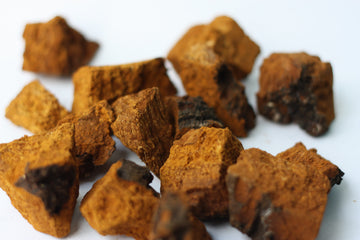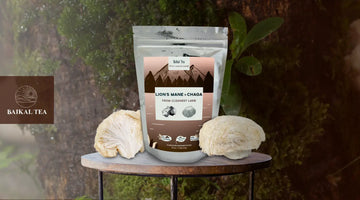
Derived from a peculiar fungus that thrives on birch trees, chaga tea is a cherished beverage with significant health benefits. This guide will equip you with the knowledge on how to prepare chaga tea, in addition to offering some creative recipes for incorporating chaga into your daily diet.
Understanding Chaga: A Peculiar Fungus with Remarkable Qualities

Despite its popular nickname, the "chaga mushroom," chaga is technically not a mushroom. The term chaga refers to an unusual growth, often likened to a sterile conk or canker, that forms on hardwood trees (typically birch) after they're invaded by the parasitic fungus known as Inonotus obliquus.
This formation consists of wood lignans and mycelium, the latter being the fibres likened to the roots. Essentially, chaga is a sclerotium: a dense mass of hardened fungal mycelium.
Chaga is a parasitic fungus that feeds off its host tree, developing into a protruding formation with incredible medicinal properties.
1. Introduction to Chaga Tea

1.1 What is Chaga Tea?
Chaga tea is a distinctive brew made from the Chaga mushroom (Inonotus obliquus), a fungus that naturally grows on birch trees in the Northern Hemisphere. This mushroom is typically found in countries like Canada, the United States, China, and Russia. The tea made from Chaga has been used for centuries due to its impressive health benefits.
1.2 Health Benefits of Chaga Tea
Chaga tea is packed with a variety of vitamins, minerals, antioxidants, and phytonutrients. Its consumption has been associated with potential benefits including improved circulation, weight-loss support, and even cancer treatment due to its high betulinic acid content. It's important to mention that the effectiveness of Chaga in treating such diseases is yet to be fully established as there has been limited research conducted on its effects.
Historical Significance of Chaga
Chaga has been lauded by numerous cultures for its health benefits. Traditional medicine practitioners in Russia, Indigenous cultures, Poland, the Baltics, Finland, China, Korea, and Japan have used chaga extracts to promote various aspects of well-being, including:
- Cardiovascular health
- Balanced blood sugar levels
- Enhanced liver, stomach, and skin health
- Energy levels
- Respiratory health
- Healthy inflammation response
- Blood purification
- Topical applications for skin healing
The Indigenous Cree community in Canada refer to chaga as Wesakechak omikih or Wesakechak's scab. According to Cree folklore, Wesakechak is a mythical figure who mistakenly threw a scab he had attempted to eat against a birch tree, where it remains to this day for the benefit of mankind. Besides medicinal uses, the Cree also use chaga in agriculture, animal breeding, as incense, and as a fire starter.
Present-Day Benefits of Chaga Tea & Chaga Powder
For a comprehensive overview of the contemporary uses of chaga and the scientific research endorsing its health benefits, refer to our article, 6 Benefits of Chaga You Need to Know. Chaga tea has been a traditional medicinal in Northern regions for centuries, where Inonotus obliquus naturally grows.
Mastering the Art of Making Chaga Tea
Traditionally, chaga has been consumed as tea in countries like Finland and Russia. The process involves immersing raw chaga chunks in hot water, which extracts the nutrients from chaga's chitinous interior.
However, an easier and more economical method of making chaga tea involves using a superior-grade pure chaga extract like Baikal’s Chaga tea.
Making tea directly from chaga pieces is the most traditional way to consume this medicinal fungus. However, this method isn't always feasible because chaga is scarce in many parts of the world.
Brewing Chaga Tea: The Traditional Way
The most traditional method of making chaga tea involves simmering chaga chunks or powder in water. The trick is to keep the water temperature between 140°F and 160°F (60°C and 71°C), as boiling water could destroy chaga's beneficial antioxidants.
The quantity of chaga used depends on the size of the chunks and the desired strength of the tea. As a rule of thumb, use about a cup of water for every 1-inch chunk of chaga. Allow the chaga to simmer for at least 15 minutes, and up to an hour for a stronger brew.
Making Chaga Tea: Two Recipes to Try
Now that we've explored the impressive benefits of Chaga, let's learn how to prepare Chaga tea. Here are two simple yet delicious Chaga tea recipes for you to try.
1. Chai Chaga Mushroom Tea

This sugar-free, vegan, and gluten-free recipe packs a punch of flavour and health.
Preparation Time: 8 minutes
Ingredients:
- 200ml of purified water
- 1 Baikal Tea Sachet
- 1/2 tsp of ground cinnamon
- 1/4 tsp of ground cardamom
- 1 star anise or 1/4 tsp of ground star anise
- ½ Tbsp of black peppercorns or 1/8 tsp of black pepper
- A splash of nut milk of your choice
Method:
- Add the water and Chaga tea sachet into a cup.
- Add the spices into your tea.
- Enjoy your Chaga tea hot or cold, with a splash of nut milk. You can store the tea in the fridge for up to 14 days.
2. Vanilla Chaga Mushroom Tea

This Chaga tea recipe is also sugar-free, vegan, and gluten-free. With a hint of vanilla, it's delightfully aromatic and soothing.
Preparation Time: 8 minutes
Ingredients:
- 200ml of purified water
- 1 Baikal Chaga Tea sachet
- 2 drops of vanilla extract
Method:
- Pour water into a cup and steep a bag of Baikal Chaga Tea.
- Once brewed, add 2 drops of vanilla extract to the tea. Enjoy it hot or cold. Store the leftover tea in the fridge for up to two weeks.
As you sip your homemade Chaga tea, remember that this simple beverage is a potent combo of antioxidants, antifungals, and adaptogens. With each sip, you're gifting your body incredible health benefits, from cancer prevention to immune system support. So, why wait? Start your Chaga journey today with these easy-to-make Chaga tea recipes!





